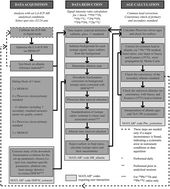Non-matrix-matched standardisation in LA-ICP-MS analysis: general approach, and application to allanite Th–U–Pb dating†
Abstract
To make use of the full geochronological potential of accessory minerals such as zircon, allanite, monazite, and titanite, high spatial resolution isotopic analysis of the Th–U–Pb system is required. Laser ablation ICP-MS techniques are increasingly applied for this purpose, yet the matrix-dependence of analysis and the paucity of high-quality standards for most of these minerals impose major limitations – as for all in situ microbeam analytical techniques. A novel approach for LA-ICP-MS data reduction is presented here that allows for non-matrix-matched external standardization while yielding highly accurate isotopic ratios and age data. The matrix-dependent downhole fractionation during laser ablation is empirically quantified and corrected; hence, well constrained reference materials (here: Plesovice zircon) can be employed as primary standards for the analysis of rare yet petrologically essential minerals (here: SISS, CAP, and TARA allanite). Using laser beam sizes of 32 and 24 μm, transient isotope ratio data show systematic differences between zircon and allanite; these are attributed to matrix effects and are combined to correct for the temporal evolution of the matrix-dependent downhole fractionation. The new data reduction technique was tested on three allanite standard reference materials demonstrating analytical accuracy at precisions equal to those achieved by ion probe and LA-ICP-MS rastering. The analytical procedures presented here could be applied to any combination of two different matrices (calibration standard and sample), thus greatly mitigating dependence on precisely characterized calibration materials, and contribute to establishing universally applicable LA-ICP-MS dating protocols that can be applied to a much broader range of minerals and chronometers.



 Please wait while we load your content...
Please wait while we load your content...